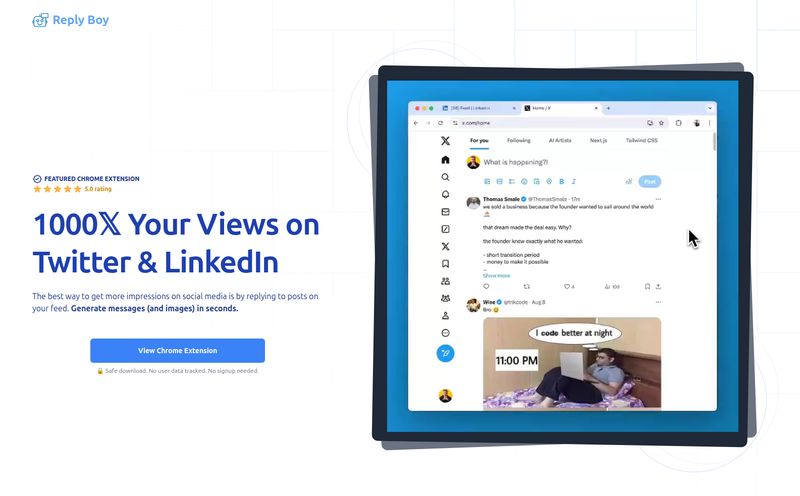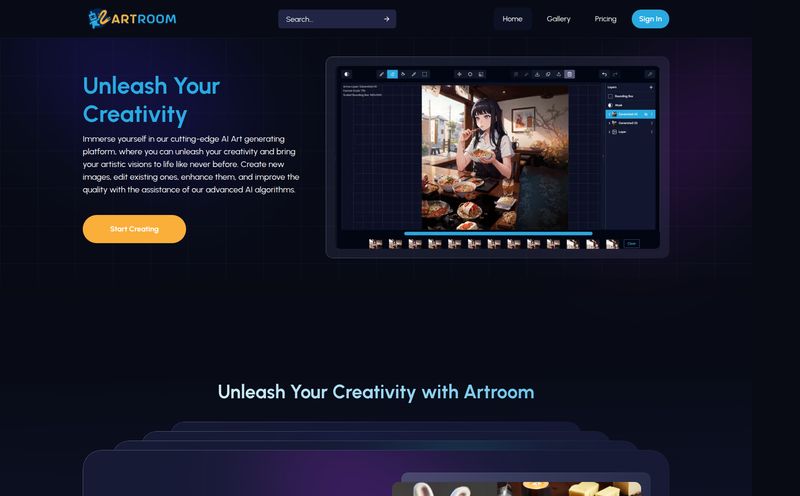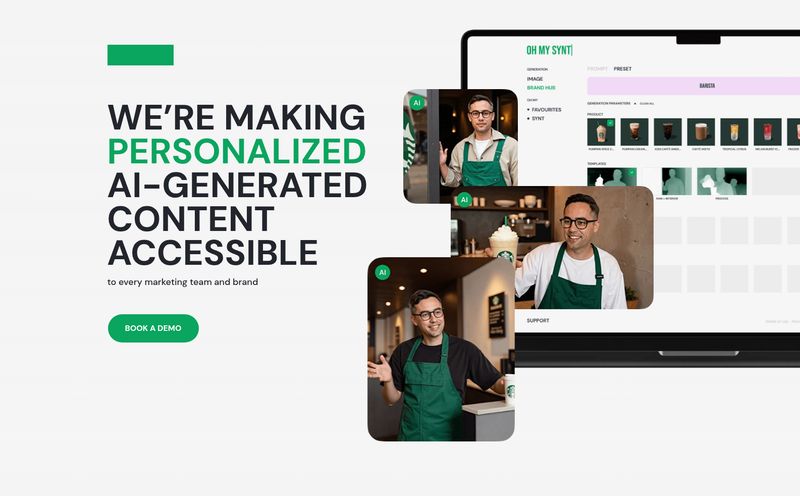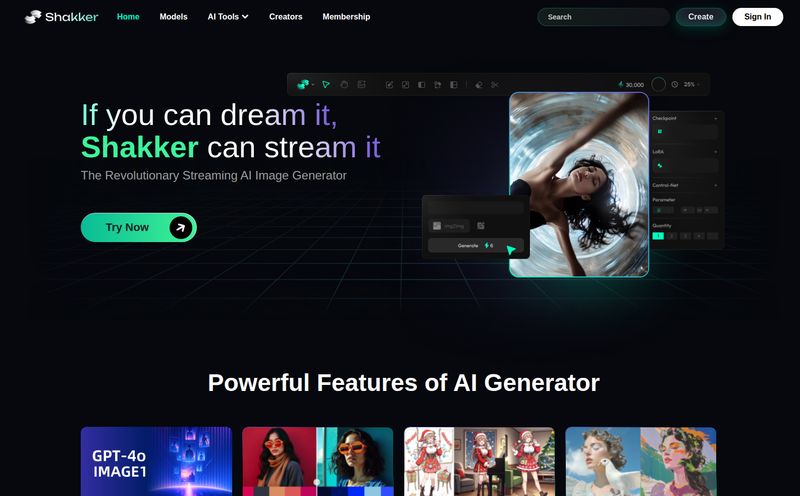For years, the storyboarding process has been the unsung hero and the biggest bottleneck of pre-production. It's that critical step where words on a page start to look like a movie. But man, it can be a slog. You're either trying to hire a decent artist who doesn't cost an arm and a leg, or you're stuck trying to translate your grand vision into stick figures that... well, they lack a certain je ne sais quoi.
I’ve been in the content and traffic game for years, and I’ve seen the AI wave crash over everything from writing to image creation. Most of it is impressive, some of it is baffling, and a lot of it feels like a solution looking for a problem. So when I started hearing chatter about an AI storyboard tool called Rubbrband, my curiosity was piqued. Another shiny AI toy, or something genuinely useful? I had to find out.
This isn't just another product rundown. This is my deep dive, a no-fluff look at whether Rubbrband is the real deal for filmmakers, ad agencies, and creators drowning in pre-production woes.
What Exactly is Rubbrband? (And Why Should You Care?)
At its heart, Rubbrband is a script-to-storyboard platform. You feed it your script, and it spits out a storyboard. Simple enough. But the magic, or at least the claimed magic, is in the details. This isn't just a generic image generator randomly pulling from your text. Rubbrband says its AI understands filmmaking.
Think about that. It’s built to recognize things like shot types (close-up, wide shot), camera movements, character names, and scene descriptions. It’s like having a lightning-fast storyboard artist on your team who’s not only a great illustrator but has also memorized every book on cinematography. The goal is to give you a visually consistent, professional-looking storyboard in minutes, not days or weeks.
For anyone who’s ever tried to pitch a project with a clunky PDF and a prayer, the appeal is obvious. It’s about speed, clarity, and getting everyone on the same page, visually, from the get-go.
The Four-Step Process: How It Works in Practice
The Rubbrband site lays out a pretty clean four-step workflow. No convoluted menus or a steep learning curve. It feels designed by people who actually understand that creatives are often short on time and patience.
First, you Upload your script. It takes a PDF or plain text file, which covers pretty much everyone. The platform then parses your script, automatically identifying scenes, characters, and action beats to suggest initial shots.
Second, you See instant visuals. This is the moment of truth. The AI gets to work, generating cinematic sketches for each shot. A huge selling point here is the promised consistency in style, characters and locations. No more explaining to your DP why the main character’s haircut changes three times in one scene.
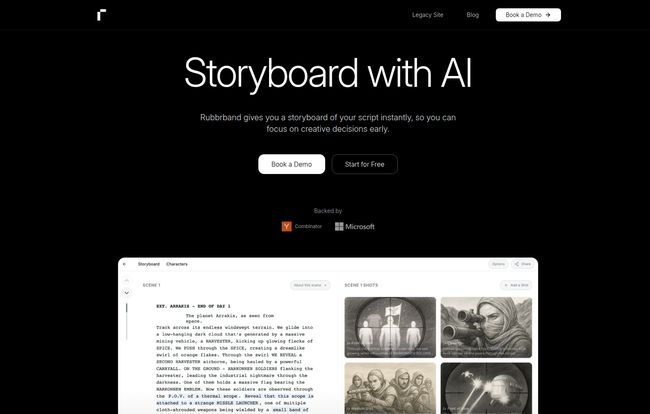
Visit Rubbrband
Third, and this is where I got really interested, you Refine with director tools. This is crucial. A static, unchangeable AI output would be a deal-breaker. Rubbrband lets you edit shots using natural language. You can just type things like, “Change to a low-angle shot,” or “Make the mood more somber,” and the AI adjusts the image. That’s a powerful feedback loop that keeps the human in the driver's seat.
Finally, you Export and collaborate. Once you’re happy, you can share the boards with your team, get feedback, and export them for pitch decks or animatics. It’s built for a collaborative workflow, not just a solo artist’s tool.
The Good, The Bad, and The AI. My Honest Take.
Alright, so it sounds great on paper. But how does it hold up in the real world? Like any tool, it has its brilliant moments and its… teachable moments.
Where It Shines: The Time-Saving Miracle
The speed is undeniable. Generating a full set of storyboards for a scene in the time it takes to make a cup of coffee is just… wild. This completely changes the pace of pre-production, allowing for more experimentation. Don't like a sequence? Tweak the script and regenerate it. No artist’s feelings hurt, no extra budget burned.
The style consistency is another massive win. The hand-drawn sketch aesthetic looks professional and, more importantly, it looks uniform. It gives your project an immediate sense of coherence. And those “Director Tools” I mentioned? They’re the secret sauce. The ability to iterate on a shot with simple text commands is what separates this from a simple image generator. It feels less like a machine and more like a very responsive, very fast assistant.
The Reality Check: Where You Might Get Stuck
Let's be real. If you are a director with a hyper-specific, Stanley Kubrick-level vision for every single pixel, you might find the AI a bit confining. You are, to some extent, working within the aesthetic and interpretive framework of the AI. It’s a collaboration, not a direct mind-to-paper transfer.
Also, the old maxim of “garbage in, garbage out” is in full effect here. If your script is vague, with unclear descriptions or poorly defined action, your storyboards will reflect that. You can’t just write “they fight” and expect a perfectly choreographed, emotionally resonant sequence. The quality of the output is directly proportional to the clarity of your input. So, it kinda forces you to be a better writer, which isn't a bad thing, I suppose.
Let's Talk Money: Rubbrband Pricing Explained
So, what's the damage? The pricing structure is actually pretty straightforward and caters to different levels of need. I appreciate that they have a free option, so you’re not buying blind.
| Plan | Price | Key Features |
|---|---|---|
| Free | $0 / forever | 3 scenes per month, 3 new shots + edits, Standard quality images. |
| Pro | $49 / per seat / month | 80 scenes per month, 50 new shots + edits, HD images. |
| Enterprise | Contact Sales | Custom scenes & shots, dedicated queue, SSO, SOC 2 compliance, dedicated support. |
The Free plan is the perfect sandbox. It’s enough to test out a key scene from your script and see if the workflow and style work for you. The Pro plan, at $49 a month, feels like the sweet spot for indie filmmakers, YouTubers, and small agencies. When you compare that to the cost of hiring a human artist for even a single short film, the value proposition is pretty compelling. The Enterprise plan is clearly for the big studios and production houses that need all the bells and whistles like enhanced security, unlimited seats, and dedicated support.
Who is This Tool Really For?
After playing around and analyzing its features, I've got a good sense of who would fall in love with Rubbrband.
- Indie Filmmakers: Working with tight budgets and even tighter timelines? This is your new best friend. It professionalizes your pitch materials and streamlines pre-production.
- Ad Agencies: Need to whip up concept boards for a client pitch by tomorrow? Done. It allows for rapid visualization that can help sell an idea fast.
- Content Creators: If you're a YouTuber or social media creative looking to plan more complex shoots, this is a fantastic way to level up your planning process beyond just a shot list.
Who might want to stick to the old ways? Probably the aforementioned auteur who sees storyboarding as a deep, personal part of their artistic process. And that’s okay! This is a tool to solve a problem, not replace an art form.
A Final Thought
Tools like Rubbrband aren't about replacing human creativity. I think that's the wrong way to look at it. They're about removing friction. They handle the tedious, time-consuming parts of a process, freeing up creators to focus on what really matters: the story, the performance, the emotional core of the project. It’s a powerful assistant, a force multiplier for your own vision.
Is Rubbrband perfect? No tool is. But is it a genuinely useful, powerful, and potentially game-changing piece of software for visual storytellers? Absolutely. The fact that you can try it for free makes it a complete no-brainer. Give it a shot on your next project. You might be surprised at how much time you get back.
Frequently Asked Questions About Rubbrband
- 1. Does Rubbrband's AI maintain character consistency across shots?
- Yes, this is one of its core features. The AI is designed to recognize character names and maintain their appearance, as well as locations, throughout the scenes you generate for a more cohesive storyboard.
- 2. Can I customize the art style of my AI storyboard?
- The platform generates images in a consistent, professional hand-drawn sketch style. While you can't fundamentally change this core style (e.g., to photorealistic or anime), the "Director Tools" allow you to use text prompts to adjust the tone, lighting, and framing of the shots to better match your vision.
- 3. Is Rubbrband a good tool for beginners in filmmaking?
- I'd say it's fantastic for beginners. It lowers the barrier to entry for one of the most intimidating parts of pre-production. It helps you learn to think visually and translate your script into actual shots, which is an invaluable skill.
- 4. How is this different from a general AI image generator like Midjourney?
- The key difference is its specialization. While tools like Midjourney are amazing for creating single, stunning images, Rubbrband is purpose-built for the narrative flow of storyboarding. It understands script formatting, cinematic language (shot types, angles), and maintains consistency, which general tools aren't designed to do.
- 5. Is my creative work safe on the platform?
- According to their feature list, Rubbrband uses end-to-end encryption to protect your creative assets. For larger productions, the Enterprise plan also offers advanced security features like SOC 2 compliance, which is a big deal for studios concerned about leaks.
